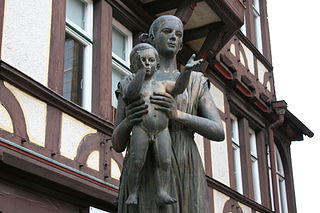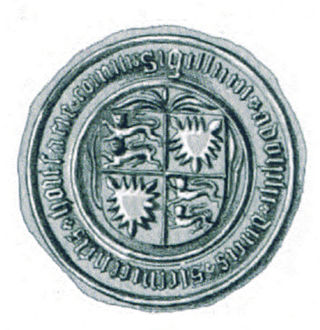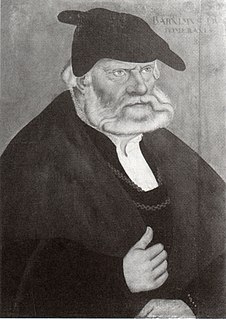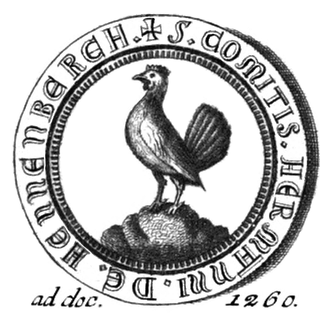
Henry I of Hesse "the Child" was the first Landgrave of Hesse. He was the son of Henry II, Duke of Brabant and Sophie of Thuringia.

Günther XXI von Schwarzburg, disputed King of Germany, was a descendant of the counts of Schwarzburg.

Adolphus XI of Schauenburg, as Adolph I Duke of Schleswig, and as Adolph VIII Count of Holstein-Rendsburg, was the mightiest vassal of the Danish realm.

Louis V, called the Brandenburger, a member of the House of Wittelsbach, ruled as Margrave of Brandenburg from 1323 to 1351 and as Duke of Bavaria from 1347 until his death. From 1342 he also was co-ruling Count of Tyrol by his marriage with the Meinhardiner countess Margaret.

Anne of Bohemia and Austria was a Duchess of Luxembourg in her own right and, as a consort, Landgravine of Thuringia and of Saxony.
Theodoric I, called the Oppressed, was the Margrave of Meissen from 1198 until his death. He was the second son of Otto II, Margrave of Meissen and Hedwig of Brandenburg.

The House of Henneberg was a medieval German comital family (Grafen) which from the 11th century onwards held large territories in the Duchy of Franconia. Their county was raised to a princely county in 1310.

Adolf III, Count of Schauenburg and Holstein was the ruler of the Counties of Schauenburg and Holstein. He is particularly remembered for his establishment of a new settlement for traders on the banks of the Alster near the Neue Burg in Hamburg.

Barnim XI, son of Bogislaw X, Duke of Pomerania, became duke on his father's death in 1523.
Henry II, Lord of Mecklenburg, nicknamed the Lion was regent of Mecklenburg from 1287 to 1298, co-regent from 1298 to 1302 and ruled alone again from 1302 to 1329.

Herman I, Count of Henneberg was the son of Count Poppo VII of Henneberg and his wife, Jutta of Thuringia, the eldest daughter of Landgrave Herman I of Thuringia. This was Boppo's second marriage and also Jutta's second marriage. Margrave Henry III of Meissen was Herman's half-brother from his mother's side. Herman supported the election of his uncle Henry Raspe as anti-king of the Germans.

Rudolf I, a member of the House of Ascania, was Duke of Saxe-Wittenberg from 1298 until his death. By the Golden Bull of 1356 he was acknowledged as Elector of Saxony and Marshal of the Holy Roman Empire.

John Günther I of Schwarzburg-Sondershausen was the co-ruler of Schwarzburg from 1552 until 1571 and the sole ruler Schwarzburg-Sondershausen from 1571 until his death. He is regarded as the progenitor of the line Schwarzburg-Sondershausen.

Herman, Margrave of Brandenburg, also known as Herman the Tall, a member of the House of Ascania, was Margrave and co-ruler of Brandenburg with his cousin Margrave Otto IV of Brandenburg-Stendal.
Margrave Otto V of Brandenburg-Salzwedel, nicknamed Otto the Tall, was a son of Margrave Otto III and co-ruler of Brandenburg with his cousin, Margrave Otto IV.

Count George of Nassau-Beilstein, later also Count of Nassau-Dillenburg, was the third son of Count John VI "the Elder" of Nassau-Dillenburg (1536-1606) from his first marriage with Elisabeth of Leuchtenberg,

Otto IV, Margrave of Brandenburg-Stendal, nicknamed Otto with the arrow was the Margrave of Brandenburg from the House of Ascania from 1266 until his death.

Albert Anton, Prince of Schwarzburg-Rudolstadt was the ruling Count of Schwarzburg-Rudolstadt from 1662 to 1710. He was raised to Imperial Prince in 1697, however, he chose not to accept his elevation. In 1710, he was elevated again, and this time, he accepted.

Louis Günther I, Count of Schwarzburg-Rudolstadt was the ruling Count of Schwarzburg-Rudolstadt from 1612 until his death.
The Udonids (Udonen) were a German noble family, ruling as both the Counts of Stade and Margraves of the Nordmark, or Northern March, from the 9th to the 12th century. The first formal member of this family was Henry I the Bald, who took his seat in Harsefeld, part of the Duchy of Franconia, where he built a castle in 965. He was the grandson of the first Count of Stade, Lothar I, who was killed by the Great Heathen Army in the Battle of Ebstorf, and was recognized as one of the Martyrs of Ebsdorf by the Catholic Church.















